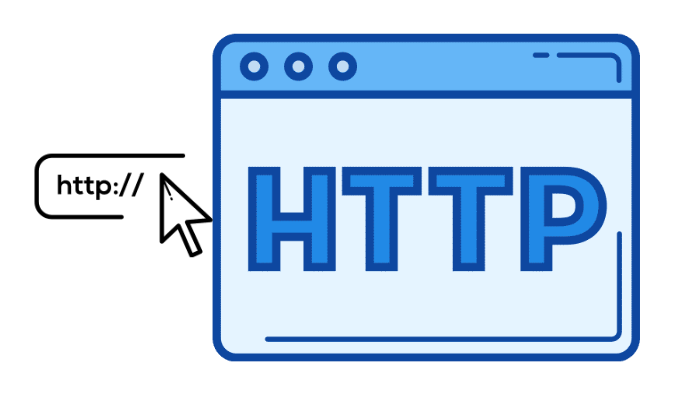HTTP Full form is HyperText Transfer Protocol, which is used to set up effective data communication. It provides a set of guidelines and standards for users over the internet to exchange information with one another. It comprises two segments, i,e. HTTP Request and HTTP Response. HTTP protocol is used to access any particular file or page over the internet.
HTTP works on the client side server, where clients make a request to the browser and the browser generates a response in the end. It is an application layer protocol designed within the guidelines of the Internet Protocol Suite. In this article, we will learn more about HTTP Full Form in detail.
HTTP Full Form Overview
The HyperText Transfer Protocol is a technology used in the modern internet to set up a communication channel between web browsers and servers. This protocol delivers images, text, videos, and other multimedia content over the world wide web.

Getting familiar with HTTP protocols and their evaluation is important to work with modern websites, applications, and digital communication systems.
| HTTP Full Form | HyperText Transfer Protocols |
| Used by | Set up communication between web browsers and servers. |
| Latest Version | HTTP/3 |
| Suitable For | Non-Sensitive Communication |
What Is HTTP?
HTTP stands for Hypertext Transfer Protocol. It is a set of rules that govern how data is exchanged between a client (usually a web browser) and a server (where websites and web applications reside). HTTP operates on the application layer of the Internet Protocol Suite and facilitates the fetching of resources, such as HTML documents, images, and videos, required to render web pages.
HTTP is stateless, meaning that each request from a client to a server is treated as an independent transaction, unrelated to any previous request. This simplicity allows for scalability but can also introduce challenges, such as maintaining session state in web applications.
Working of HTTP Protocol

HTTP follows the TCP/IP protocol and operates generally on port 80 or port 443 of HTTPS. The HTTP Protocols work on two main processes, also known as request-response models.
1. Request
A client sends an HTTP request to a server on a web browser. This request specifies the resource or files it wants to access, for example, image, video, audio, etc. The HTTP requests are typically sent to a specific URL and may include additional information such as headers, cookies, or a body for data submission.
2. Response
The server processes the request and returns an HTTP response. This response contains a status code, headers, and, optionally, the requested content. For example, an HTML file in a web development project.
3. Status Codes
HTTP responses include a status code to indicate the result of the request. You can use the HTTP status code to display different types of output results particularly to warn, congratulate, and inform about the page functionalities. For example:
- 200 OK: The request was successful.
- 404 Not Found: The requested resource does not exist.
- 500 Internal Server Error: An error occurred on the server.
Why Is HTTP Protocol So Important?

HTTP forms the backbone of web browsers and communication providing an effective route for setting up communication and retrieving information between users and web applications.
-
- Universal Adoption: HTTP standard protocol is used over the internet worldwide by all browsers and servers.
- Simplicity and Scalability: Its stateless nature allows for efficient communication and scalability.
- Versatility: HTTP supports a wide range of content types and operations.
- Foundation for Modern Web Technologies: HTTP works with APIs, web services, and frameworks, powering everything from simple websites to complex web applications.
- Effective Communication: The HTTP protocols can easily be used to set up communication between users and web browsers.
HTTP Vs HTTPS: Major Highlights

HTTPS is said to be a more secure version of the HTTP protocol. Let us know some major differences and similarities between them.
Similarities
- Both HTTP and HTTPS are protocols used in communication between a web browser (client side) and a server.
- The request response structure of communication, including GET, POST, PUT, and DELETE are the same for both protocols.
- HTTP and HTTPs both use TCP/IP as the underlying transport protocol.
- HTTP default port is 80, while HTTPs default port is 443. However, these can be configured.
- HTTPS is a more secure form of HTTPs version.
- Both are designed for accessing resources on the web including websites, APIs, and others.
Difference
Let us know some of the major differences between HTTP and HTTPS given below,
| HTTP | HTTPS |
| The HTTP full form is HyperText Transfer Protocol | The HTTPS full form is HyperText Transfer Protocol Secure |
| HTTP is not secure and data is transmitted as plain text and can be intercepted. | HTTPS is more secure and uses SSL/TLS encryption to protect data during transmission. |
| There is no encryption in HTTP and communication is vulnerable to eavesdropping. | HTTPS encrypts data, making it unreadable to third parties. |
| Default port: 80 | Default port: 443 |
| HTTP does not require an SSL/TLS certificate. | HTTPS requires an SSL/TLS certificate issued by a trusted Certificate Authority (CA). |
| HTTP is not preferred for search engines and could negatively impact rankings. | HTTPS is referred to by search engines and offers better SEO rankings. |
| HTTP is slightly faster due to the lack of encryption overhead. | HTTPS is slightly slower due to encryption overhead but negligible with modern hardware. |
Learn Full Stack Development With PW Skills
Become a certified full Stack Developer with PW Skills 6-months online program, the Full Stack Web Development Program. This course is suitable for beginners as well as professionals who want to start their careers in web development. Get in depth tutorials and work on real world projects under the mentorship of experienced mentors.
Learn web development frameworks and concepts like HTML, CSS, Javascript, Node.js, Express.js, etc. Get certification after completing the course.
HTTP Full Form FAQs
Q1. What is the HTTP Full Form?
Ans: The HTTP full form is HyperText Transfer Protocol. This is a communication protocol that set up communication between user or client side of the browser and the server.
Q2. What is the HTTPS Full form?
Ans: The HTTPS full form stands for HyperText Transfer Protocol Secure. It is a more secure version of the HTTP protocol and is used to set up communication between a web browser and the server.
Q3. What is the major difference between HTTP and HTTPS?
Ans: The HTTP full form is HyperText Transfer Protocol and HTTPS full form is HyperText Transfer Protocol Secure. The HTTP is suitable for normal communications where security is not a major concern, while HTTPS offers more security.
Q4. What is the default port of HTTP port?
Ans: The default port of HTTP port is 80 and the default port of HTTPS is 443.

